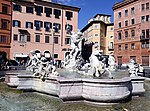Chiostro del Bramante
Italian building and structure stubsRenaissance architecture in Rome
The Chiostro del Bramante (Cloisters of Bramante) is an Italian Renaissance building in Rome, commissioned by Cardinal Oliviero Carafa in around 1500, and designed by the architect Donato Bramante.Today the building serves as a space for exhibitions, meetings and concerts. A cafe and bookshop are housed within the building. A fresco painting by Raphael, The Sibyls in the next-door church of Santa Maria della Pace, is visible from the first floor.
Excerpt from the Wikipedia article Chiostro del Bramante (License: CC BY-SA 3.0, Authors).Chiostro del Bramante
Vicolo della Pace, Rome Municipio Roma I
Geographical coordinates (GPS) Address Nearby Places Show on map
Geographical coordinates (GPS)
| Latitude | Longitude |
|---|---|
| N 41.899918 ° | E 12.471748 ° |
Address
Chiesa di Santa Maria della Pace
Vicolo della Pace
00186 Rome, Municipio Roma I
Lazio, Italy
Open on Google Maps










